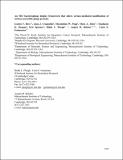M13 Bacteriophage Display Framework That Allows Sortase-Mediated Modification of Surface-Accessible Phage Proteins
Author(s)
Hess, Gaelen T.; Cragnolini, Juan J.; Popp, Maximilian W.; Allen, Mark A.; Dougan, Stephanie K.; Spooner, Eric; Ploegh, Hidde L.; Belcher, Angela M.; Guimaraes, Carla P.; ... Show more Show less
DownloadPloegh paper and supplement.pdf (3.347Mb)
PUBLISHER_POLICY
Publisher Policy
Article is made available in accordance with the publisher's policy and may be subject to US copyright law. Please refer to the publisher's site for terms of use.
Terms of use
Metadata
Show full item recordAbstract
We exploit bacterial sortases to attach a variety of moieties to the capsid proteins of M13 bacteriophage. We show that pIII, pIX, and pVIII can be functionalized with entities ranging from small molecules (e.g., fluorophores, biotin) to correctly folded proteins (e.g., GFP, antibodies, streptavidin) in a site-specific manner, and with yields that surpass those of any reported using phage display technology. A case in point is modification of pVIII. While a phage vector limits the size of the insert into pVIII to a few amino acids, a phagemid system limits the number of copies actually displayed at the surface of M13. Using sortase-based reactions, a 100-fold increase in the efficiency of display of GFP onto pVIII is achieved. Taking advantage of orthogonal sortases, we can simultaneously target two distinct capsid proteins in the same phage particle and maintain excellent specificity of labeling. As demonstrated in this work, this is a simple and effective method for creating a variety of structures, thus expanding the use of M13 for materials science applications and as a biological tool.
Date issued
2012-07Department
Massachusetts Institute of Technology. Department of Biological Engineering; Massachusetts Institute of Technology. Department of Biology; Massachusetts Institute of Technology. Department of Materials Science and Engineering; Koch Institute for Integrative Cancer Research at MITJournal
Bioconjugate Chemistry
Publisher
American Chemical Society (ACS)
Citation
Hess, Gaelen T., Juan J. Cragnolini, Maximilian W. Popp, Mark A. Allen, Stephanie K. Dougan, Eric Spooner, Hidde L. Ploegh, Angela M. Belcher, and Carla P. Guimaraes. “M13 Bacteriophage Display Framework That Allows Sortase-Mediated Modification of Surface-Accessible Phage Proteins.” Bioconjugate Chemistry 23, no. 7 (July 18, 2012): 1478-1487.
Version: Author's final manuscript
ISSN
1043-1802
1520-4812